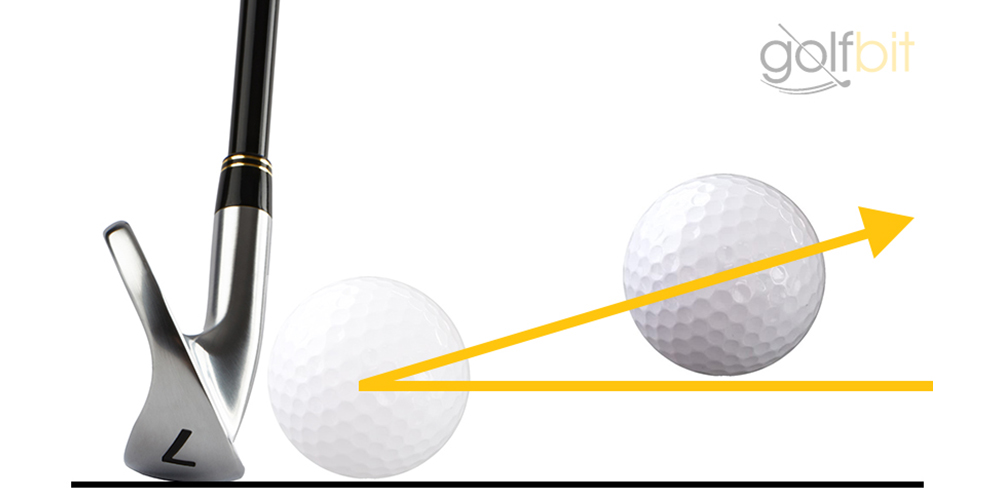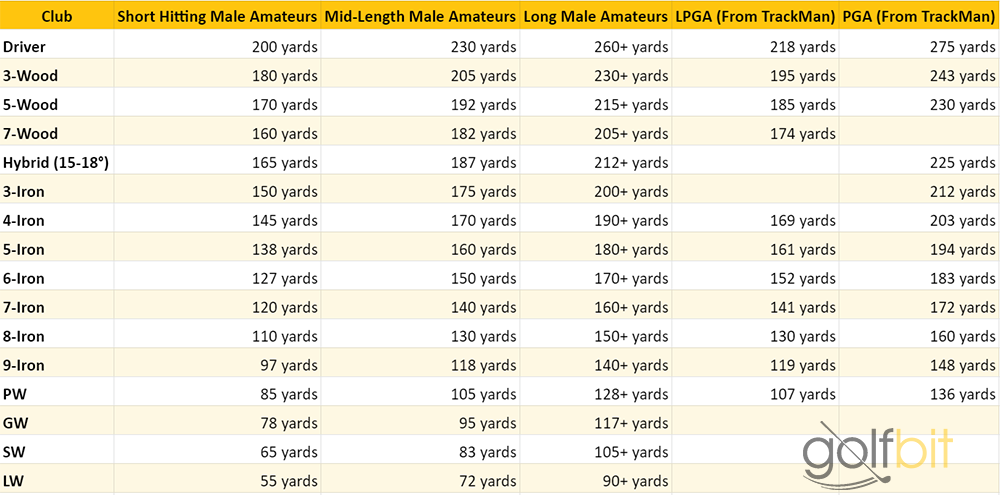Golf Club Distances w/ Chart | Averages for Am & Pro Players
Distance is critical in golf. As golfers, we're always striving for more distance off the tee and consistent yardage gaps between the rest of our clubs.
In this guide, we'll break down how far amateur golfers of various skill levels and swing speeds hit each of their clubs to give you an idea of how you stack up. We've also included PGA and LPGA carry distance averages to see how you compare with the pros.
After that, we'll cover what factors affect your golf club distances and explain how to find out how far you hit each club.
Golf Club Distances Table
The table below shows how far golfers of various skill levels and swing speeds hit each club.
We've included PGA and LPGA carry distance averages of professional golfers that TrackMan gathered.
For amateur male golfers, we've split them into groups of "short," "mid," and "long" hitters. All distances refer to carry distance (distance until the ball first hits the ground) rather than total distance (carry and roll).
| Club | Short Hitting Male Amateurs | Mid-Length Male Amateurs | Long Male Amateurs | LPGA (From TrackMan) | PGA (From TrackMan) |
| Driver | 200 yards | 230 yards | 260+ yards | 218 yards | 275 yards |
| 3-Wood | 180 yards | 205 yards | 230+ yards | 195 yards | 243 yards |
| 5-Wood | 170 yards | 192 yards | 215+ yards | 185 yards | 230 yards |
| 7-Wood | 160 yards | 182 yards | 205+ yards | 174 yards | |
| Hybrid (15-18°) | 165 yards | 187 yards | 212+ yards | 225 yards | |
| 3-Iron | 150 yards | 175 yards | 200+ yards | 212 yards | |
| 4-Iron | 145 yards | 170 yards | 190+ yards | 169 yards | 203 yards |
| 5-Iron | 138 yards | 160 yards | 180+ yards | 161 yards | 194 yards |
| 6-Iron | 127 yards | 150 yards | 170+ yards | 152 yards | 183 yards |
| 7-Iron | 120 yards | 140 yards | 160+ yards | 141 yards | 172 yards |
| 8-Iron | 110 yards | 130 yards | 150+ yards | 130 yards | 160 yards |
| 9-Iron | 97 yards | 118 yards | 140+ yards | 119 yards | 148 yards |
| PW | 85 yards | 105 yards | 128+ yards | 107 yards | 136 yards |
| GW | 78 yards | 95 yards | 117+ yards | ||
| SW | 65 yards | 83 yards | 105+ yards | ||
| LW | 55 yards | 72 yards | 90+ yards |
While TrackMan gathered extremely accurate data for LPGA and PGA carry distance averages, good data for amateurs is harder to come by.
There's a massive gap in skill-level and swing speeds among amateur golfers. Golfers of various handicaps also achieve their handicaps in a variety of ways. A 5-handicap golfer could be a super fast swinger in their athletic prime or a senior golfer who has lost distance over the years.
For our amateur short, mid, and long hitting male amateur distances, we relied on the limited available large sample data and what we've seen personally from loads of amateur golfers.
Because these yardages are for golfers of all ages, junior, middle-aged, and especially senior golfers may find themselves with distances closer to the "Short Hitting Male Amateurs" column. Most young adult to middle-aged male golfers should carry the ball to at least the "Mid-Length Male Amateurs" distances, while faster swingers of these ages can reach the distances in the "Long Male Amateurs" column.
Lastly, aside from LPGA professionals, we didn't include other female golfers in our distance table. There's even less data available for amateur female golfers than for male amateurs. We've also found a more considerable disparity in how far female recreational players hit the ball. Basically, we weren't confident we could provide any accurate/valuable information for female amateurs' distances.
What Affects Distance in Golf
There are a lot of factors that influence your golf club distances.
Club Speed
Club speed is the most significant factor in determining distance.
To illustrate this, look at the correlation of club head speed vs carry distance for PGA Tour players in the scatter plot below:
 2020 PGA Tour Players Average Club Head Speed vs Average Carry Distance, Data Source: pgatour.com
2020 PGA Tour Players Average Club Head Speed vs Average Carry Distance, Data Source: pgatour.com
Assuming all other things are equal, more swing speed means more energy that can be transferred from the club to the golf ball, resulting in higher ball speed. Higher ball speed means the ball will travel a further distance.
Factors like impact location on the club face, club path, spin rate, and launch angle also play a large part in how far a ball travels.
Impact Location Golf Iron and Driver Sweet Spot
Golf Iron and Driver Sweet Spot
An impact out of the "sweet spot" of your irons or woods will lead to a higher smash factor than strikes that are too low, too high, off the toe, or off the heel.
Smash factor is a calculation of how well you converted club speed into ball speed (Smash Factor = Ball Speed / Club Speed).
In particular, strikes out of the heel and low strikes can kill distance with the driver.
 Strike Location's Effect on Ball Speed, Spin Rate, and Distance. Source: TXG Tour Golf Experience on YouTube
Strike Location's Effect on Ball Speed, Spin Rate, and Distance. Source: TXG Tour Golf Experience on YouTube
If you struggle to consistently hit the ball with or near the sweet spot of your club face, you'll have issues with the consistency of your yardages.
Spin Rate and Club Path
Spin rate plays a large role in how far you'll hit the ball and the shapes of your shots.
A lot of golfers put too much spin on the ball with their driver either because of too much club loft, poor strikes (bad impact location), or poor club face control (the direction the club face is aimed relative to your swing path).
If you feel you're hitting the ball well but should be getting a few more yards, work with a club-fitter to see if your driver has too much loft. The ideal spin rate depends on your club speed, but too much spin will cost you yards.
Slices and hooks are caused by the club face being aimed too open (slice) or too closed (hook) relative to the club path. This can lead to both too much spin and the ball's spin axis being too strongly left-to-right or right-to-left.
 Spin-Tilt Axis, Source: ForeSight Sports
Spin-Tilt Axis, Source: ForeSight Sports
If your club face is open (aimed right) relative to your club path, this can both cause too much spin and will cause the ball to spin too left-to-right on its spin axis. You'll lose a lot of yards from a slice as the ball travels left-to-right rather than straight.
Launch Angle
For each club, there is an optimal amount of spin and an optimal launch angle. Launch angle is the angle of a golf ball's initial ascent relative to the ground.
 Launch Angle
Launch Angle
Launching the ball too high or too low will cost you distance.
While launch angle problems could be due to your swing, they can also be caused by playing the wrong clubs for your swing. If you feel like you're hitting the ball too high or too low, work with a club-fitter to dial in your clubs.
Factors Out of Your Control
There are also factors out of your control that can affect distance, like temperature and altitude.
Every 10 degrees that the temperature rises can easily lead to a couple of yards of additional ball flight with a driver.
If you drive the ball 240 yards at sea level, you will carry it around 255 yards in Denver's mile high altitude.
How to Find Your Distances
If you're looking to better understand how far you hit each club, we'd recommend purchasing a launch monitor or finding a range with a launch monitor.
To get accurate distances, you'll also want to make sure that you're hitting the same golf balls you normally play on the course.
Many golf ranges have cheap, inconsistent, or even balls purposefully made not to fly as far as normal golf balls.
Your typical range ball can easily cost you 10+ yards with the driver, while a limited flight range ball can lose you 30+ yards of distance with driver compared to a premium golf ball.
